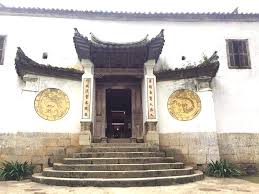Top experience you may interested in:
Unraveling the Enigma of Hmong King Palace
 Hmong King Palace, also known as Vương Family Palace, is a grand structure constructed in the late 19th century, boasting a unique architectural blend of diverse cultures and shrouded in mysterious tales. Let Hidden Land Travel guide you through the impressive features of Hmong King Palace, making it an extraordinary tourist destination.
Hmong King Palace, also known as Vương Family Palace, is a grand structure constructed in the late 19th century, boasting a unique architectural blend of diverse cultures and shrouded in mysterious tales. Let Hidden Land Travel guide you through the impressive features of Hmong King Palace, making it an extraordinary tourist destination.
The Essence of Hmong King Palace
Hmong King Palace, also known as Vương Family Palace, is nestled in the Sà Phìn valley, Lũng Phìn commune, Đồng Văn district, Hà Giang province, approximately 125km away from the city center and only 15km from the famous Đồng Văn Karst Plateau. This historical mansion is intertwined with the lives and achievements of two prominent Hmong figures, King Mèo Vương Chính Đức and his son, King Chí Sình (or Vương Chí Thành). King Mèo Vương Chính Đức (1886 – 1962) led the feudal regime in the mountainous region of the Hmong ethnic group, earning him the powerful title of “King Mèo.” His son, King Chí Sình, followed a revolutionary path and made significant contributions to the country, earning him the position of a member of the National Assembly for two consecutive terms.
Historical Background of Hmong King Palace
The construction of Hmong King Palace commenced in 1898 and was officially completed in 1907, requiring a colossal sum of 150,000 silver Đông Dương coins, equivalent to 150 billion VND today. The palace’s design and construction were a collaborative effort between craftsmen from Southern China’s Yunnan province and the Hmong people, resulting in a vast structure covering an area of over 1200m2 on approximately 3000m2 of land. Due to its enduring history and undeniable cultural value, Hmong King Palace was designated as a national heritage site by the Ministry of Culture, Sports, and Tourism in 1993, remaining a historical gem for nearly a century. Notably, the construction of the palace took five years, entirely relying on manual labor without any machinery assistance.
Unveiling the Unique Architecture of Hmong King Palace
What Makes the Palace Design Special?

Hmong King Palace is situated at the foot of a valley, surrounded by a higher ground, offering excellent defensive protection during times of intense warfare. After more than a century, the palace remains intact, providing visitors with an authentic experience akin to its inception.
The interior architecture of the palace is a fusion of three distinct cultural influences – Hmong, French, and Chinese. The structure comprises 4 horizontal houses and 6 vertical houses, forming three sections – the front court (for guards and servants), the middle court, and the rear court (residential and working areas) with 64 small chambers arranged into two levels. To ensure sturdiness, builders used green stones for construction, enabling the palace to withstand both enemies and the test of time. The walls and columns are crafted from wood, exuding an air of grandeur and elegance for each chamber. Additionally, locally fired clay tiles were employed for roofing, facilitating easier shaping while maintaining durability. Overall, Hmong King Palace showcases harmonious unity amidst its three cultural influences, resulting in a cozy and welcoming ambiance that perfectly blends with the surrounding landscape.
Interior and Furnishings of Hmong King Palace
The majority of interior furnishings associated with King Mèo’s reign are well-preserved to this day. Only a few items made of stone pine were later replaced with cedar and teakwood to prevent deterioration over time. The wooden elements bear the local cultural identity with intricate carvings depicting native flowers such as apricot blossoms and peach blossoms. The house pillars are designed to resemble opium fruit, a crop King Mèo cultivated for revenue to construct the palace. Additionally, some Western-influenced features found within the palace include a stone goat milk bath, glass windows next to fireplaces, and granite doorsteps connected by wrought iron frames, reflecting French architectural traits.
Legends Surrounding Hmong King Palace
The enduring existence of Hmong King Palace is accompanied by legends and stories passed down through generations.
One legend states that originally, King Mèo Vương Đức Chính’s residence was on a tall mountain leg, adjacent to a vast mountain pass. Upon receiving advice that the location was not auspicious, the Vương family sought the expertise of an astrologer and geographer to quickly find a favorable and harmonious site. The renowned Master Trương Chiếu, summoned from China, chose Sà Phìn as the new residence for King Mèo. Master Trương Chiếu firmly believed that the valley surrounding Sà Phìn resembled a turtle’s back, building on its back would bring wealth and prosperity, as well as unite heroic forces.
Another mysterious legend revolves around the time of King Chí Sình, where the entire Vương family was ensnared in a curse by a Han feng shui master, nearly depriving the family of an heir. King Mèo, suffering from back pain during his lifetime, tried various remedies and elixirs without relief. A Han master declared that King Mèo’s tomb was atop a dragon’s back, signifying ancestral guilt. Consequently, King Mèo relocated the tomb to another site, suspecting that the Han master had falsely accused him for malicious intentions. Due to this violation of taboos, King Mèo’s first three wives were unable to bear children. It was only the fourth wife who gave birth to a son named Vương Duy Thọ.
Hmong King Palace (Vương Family Palace) stands as a captivating destination amidst the wondrous nature of Hà Giang, with its pristine mountains and picturesque landscapes. If you have the opportunity to visit, immerse yourself in the ancient ambiance and pay homage to King Mèo’s heroic contributions. Additionally, you can explore nearby attractions such as the Pao Family House, Sủng Là Valley, and Lũng Cú Flagpole to optimize your travel experience.
Top must-visit attraction in Ha Giang



